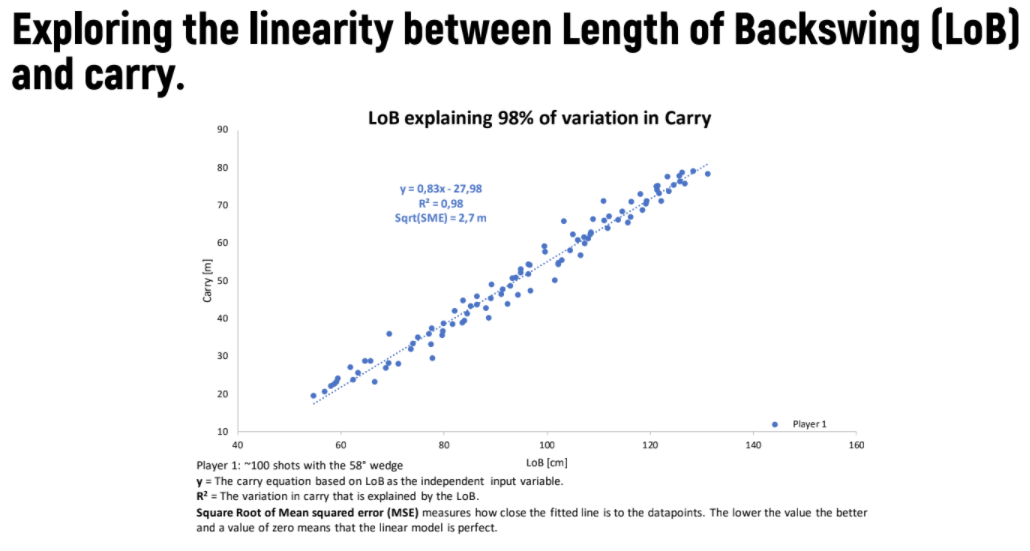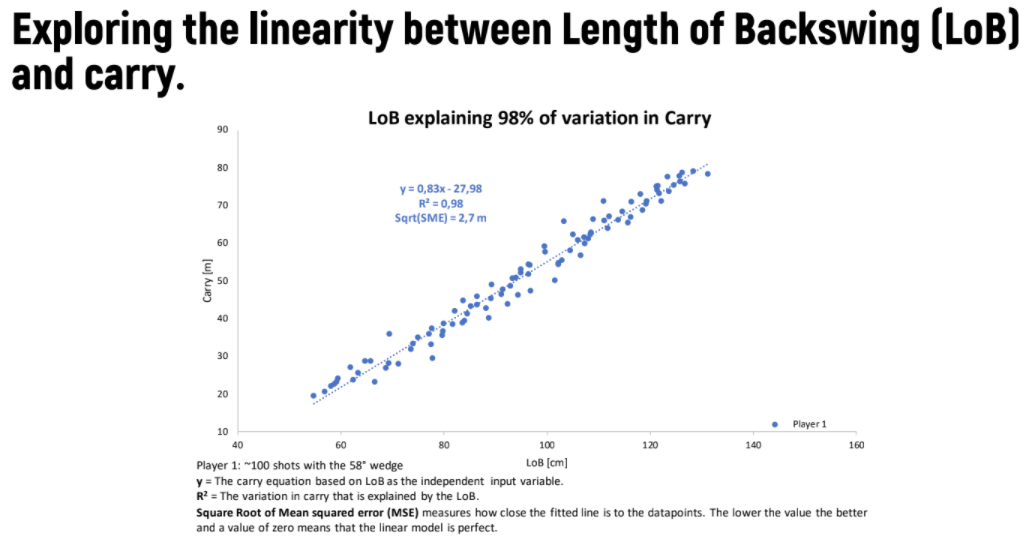-
Posts
17 -
Joined
-
Last visited
deWiz Golf's Achievements
-
deWiz Golf Swing Modifier - 2023 Forum Review
deWiz Golf replied to GolfSpy_APH's topic in Forum Testing Reviews
Because we're on the topic of the Level 7 Learning Stimuli... quick fun story for you all. We had done an interview with a British Pro earlier in the year (you can watch it HERE) and he talked about how he will actually use the Learning Stimuli during practice rounds to help simulate added "pressure" that he'll face throughout the tournament. So, if he has a 100 yard wedge shot, he knows the backswing length he's looking for and will activate the Learning Stimuli on Level 7 with really tight backswing length parameters as a way to simulate that tournament pressure. Interesting idea that I hadn't heard anyone mention until that conversation! -
deWiz Golf Swing Modifier - 2023 Forum Review
deWiz Golf replied to GolfSpy_APH's topic in Forum Testing Reviews
As @Jnoble89 mentioned in a previous answer, the deWiz Transition measurement is taken 8 inches into the downswing, which means it's entirely possible for the downswing plane to start above the backswing plane (hence the + deWiz Transition measurement) and then through the rest of the downswing the hand plane drops below the backswing plane creating the in-to-out path you see from the launch monitor (I would suggest looking at the trace lines of the deWiz avatar to see this visually). In general, particularly with higher caliber of players, we do tend to see a lot of golfers that have a slightly positive deWiz Transition number that result in an in-to-out path because of their ability to shallow out through downswing. Viktor Hovland would be a great example of someone that would have a + deWiz Transition, negative Steepening/Shallowing measurement, and in-to-out path. You can think of the Transition measurement as your "baseline". If you're producing a perfectly straight ball flight (0 path) with a +1.5 inch Transition, then you can treat 1.5 has your own "Zero". -
deWiz Golf Swing Modifier - 2023 Forum Review
deWiz Golf replied to GolfSpy_APH's topic in Forum Testing Reviews
-
deWiz Golf Swing Modifier - 2023 Forum Review
deWiz Golf replied to GolfSpy_APH's topic in Forum Testing Reviews
Here are a few additional resources with data averages of the user base as well as TOUR player data. Should help for reference! -
deWiz Golf Swing Modifier - 2023 Forum Review
deWiz Golf replied to GolfSpy_APH's topic in Forum Testing Reviews
Absolutely! We have a member Facebook group for deWiz users to bounce thoughts/questions/ideas off of. We also have a Learning Center on our website that we are constantly updating with drills and data findings and other useful information. And I'm also always eager to set up calls with our users to help answer any questions that people may have! We certainly understand that our platform and data is a new way of looking at the golf swing, but ultimately when I meet with new deWiz users, I can typically get them pointed in the right direction after 15 minutes of chatting. Unlike our co-founders, I'm no professional golfer ha! I'm just your typical 10-handicap trying to get better like everyone else! -
deWiz Golf Swing Modifier - 2023 Forum Review
deWiz Golf replied to GolfSpy_APH's topic in Forum Testing Reviews
Appreciate all the great feedback from the testers so far! For everyone following and interested in deWiz, our Black Friday week sale is currently live on our website! -
Dewiz- Max hand speed
deWiz Golf replied to RL12's topic in Training Aids, GPS Devices, Apps, Accessories & More!
Hi @RL12... thanks for the question. To answer your initial question, the Max Hand Speed number that is given in the data sheet is the speed measurement of the fastest point your hands are moving in the downswing. The Distance to Impact number is the distance between the Max Hand Speed point and impact (along the continuous hand path arc). In genera, we find most high level players produce MHS in the 15-20 inch range. The reason for this is that the hands need to begin to decelerate prior to impact to allow the club head to release through the ball. Scott Cowx did a great series on this discussing linear vs. angular velocity that you can find here: https://dewizgolf.com/blogs/learning-center/understanding-linear-vs-angular-velocity-with-scott-cowx ... these are very technical, but help to demonstrate why this is important. You mentioned that you've checked out the website, but I'll link a few other drill videos here for you to work on. https://dewizgolf.com/blogs/learning-center/the-drill-used-by-pros-to-improve-hand-speed-with-zach-allen https://dewizgolf.com/blogs/learning-center/slam-on-the-brakes-for-an-efficient-swing I'd also suggest looking at other drills and tips from coaches on YouTube on this topic, as there are a variety of different pieces of content that discuss this concept! Hope this helps! -
Dewiz…….Anybody used this?
deWiz Golf replied to fozcycle's topic in Training Aids, GPS Devices, Apps, Accessories & More!
Great questions @404yds and it's great to hear that deWiz has provided additional insights into your swing that you didn't expect to see! In terms of other data insights that we've found, there are a few that standout. When looking at Max Hand Speed and the Distance to Impact that MHS occurs, we've found that the optimum range to maximize efficiency in the golf swing is in the 17-19 inch range. And relatively speaking, a player's Distance to Impact should gradually increase as the club gets longer (i.e. Driver DTI > Long Iron DTI > Short Iron DTI, etc.) The new Steepening/Shallowing measurement is also very interesting. Not surprisingly, most TOUR players we've tracked and high level players are generally pretty neutral in this number and most have a slight Shallowing (negative number). There's a very high correlation to high handicappers that have high IDDx measurements (> 20°), largely positive Transition measurements (> 3 inch Over the Top) and significant Steepening (> 5°). So, those three measurements all tend to work in tandem with each other! We've also talked about it in the past, but again on a relative scale, a player is going to increase their ball speed and club head speed simply by increasing their Length of Backswing! -
Dewiz…….Anybody used this?
deWiz Golf replied to fozcycle's topic in Training Aids, GPS Devices, Apps, Accessories & More!
Thanks for the follow up question! A 1.2 inch tolerance is a really good spot to live within the DistWedges Mode and as you get more and more familiar with your backswing lengths, you can work on maybe setting that tolerance even lower! I would probably suggest not shrinking the tolerance threshold until you're hitting the mark 80+% of the time. What we find with higher level players is not only is the variance in hitting the desired backswing length lower, but they also have multiple backswing lengths that they are capable of producing on command - whereas higher handicap players may just work on one or two different swing lengths. -
Dewiz…….Anybody used this?
deWiz Golf replied to fozcycle's topic in Training Aids, GPS Devices, Apps, Accessories & More!
Welcome to deWiz! I'd invite you to checkout our YouTube Page, where we have plenty of tutorial videos and webinars related to the various aspects of deWiz. In regards to your question about the DistWedge gears, the idea here is to really be able to marry the "FEEL" of your half-swing or 10 o'clock swing or hip-high swing - whatever wedge philosophy you currently - with the "REAL" of whether or not you're in fact taking the club back the same distance each time. The best suggestion would be to start off in Discovery Mode and hit 10 or so full wedge shots and determine take the average Length of Backswing for those 10 swings. This will be your first "gear" in the DistWedges Mode. We find that most people will then set their additional gears at 6-7 inch increments (or about 20 cm). So, if your full wedge is a 42 inch LoB, try setting the the other two gears to 36 and 30 inches. Work on mastering those three LoBs with each of your wedges and watch how quickly your distance control will improve! -
Shorter backswing better wedge shots. Anyone else?
deWiz Golf replied to 404yds's topic in General Q&A
Really interesting conversation going on here! For those that may not be familiar with deWiz, this is the exact type of solution that we help golfers with on our platform. Worn on the lead wrist, deWiz will track and physically measure the distance your hands travel in the swing. By knowing those backswing length measurements on every single swing, you'll know right away whether or not you're hitting those intended marks rather than going off of feel or having to go back and look at video. Check out some of our videos related to wedge game distance control: Also happy to answer any additional questions people may have! -
Dewiz…….Anybody used this?
deWiz Golf replied to fozcycle's topic in Training Aids, GPS Devices, Apps, Accessories & More!
To follow up on @Mrpowerssa note, the VAT is always paid by deWiz, and this issue was ultimately resolved. There was a misunderstanding with the courier as we continue to expand into new global markets. We deeply apologize for this inconvenience and as always, if you have any questions or issues, please reach out to [email protected]. Thanks everyone! -
Dewiz…….Anybody used this?
deWiz Golf replied to fozcycle's topic in Training Aids, GPS Devices, Apps, Accessories & More!
Hi RD McCoy, thank you for the questions and I’ll do my best to answer all of them for you! A user captures their “baselines” through Discovery mode which will simply give you your numbers and data without any of the Learning Stimuli feedback. You can star or “favorite” good swings to be go back and compare between good swings and bad swings to see where you need to improve. Once you get an understanding of your numbers, you can activate the Learning Stimuli within the various Practice Modes to reaffirm the swing changes you're looking to implement! deWiz will give you the plane of your swing, and by looking at the avatar and the trace lines of the swing, you’ll be able to see where you are at every point of your swing. Regarding hand speed, there is a hand speed curve below the avatar that you can scroll through and see your hand speed at every point in the swing. And in terms of the arm/forearm rotation, this is in the works and should be available for users in the near future. Hope this helps! -
Dewiz…….Anybody used this?
deWiz Golf replied to fozcycle's topic in Training Aids, GPS Devices, Apps, Accessories & More!
Hi cnosil, We only have one account here and this is the only account we are posting from. Hopefully you'll receive responses from users who can tell their story on how they are using deWiz in their training. We see deWiz users finding value in connecting the deWiz numbers to how they swing when they hit it well, i.e., how long is the swing, what tempo is it and so on. By knowing your numbers you also have a tangible reference point. A great example is deWiz wedges as it puts a number to any wedge swing so you know how long your 9 o´clock is and you don't need guess any more. Another feature with the product we see being appreciated is the portability and easy of use that allow users to compare numbers between practice and on course play and learn how their swings differ. There is a lot of new features in development, and you can follow us on social media to get tutorials and insights on how to use deWiz. As we still are quite new to the market, it takes a little time to generate enough users and reviews but they are starting to come. https://www.independentgolfreviews.com/dewiz-swing-modifier-training-aid-review/ -
Dewiz…….Anybody used this?
deWiz Golf replied to fozcycle's topic in Training Aids, GPS Devices, Apps, Accessories & More!
Being able to measure the length of backswing in actual length of swingpath enables you to get a more precise consistency in your short game. By controlling the length of your backswing you can dial in on your wedge distances as we can see a direct linearity between the LoB and the carry length. Below is data from a former European Tour player, and while the output data has been accessible for a while, now you can also get the input data from your swing.












